Frequently Asked Questions (FAQ) pages are a pivotal stage of the customer conversion funnel. Visitors who reach this page have already recognized a need and are weighing whether your solution is the right fit—your FAQs should remove friction and build confidence so they can move forward.
Your FAQ page exists to answer decision-making questions fast. Treat it like a conversion asset, not an afterthought.
Yet many sites still overlook this page’s impact. Too often, FAQs read like catch-alls instead of focused guides that resolve objections and nudge visitors to buy, sign up, or contact sales.
Give your FAQ a clear purpose. Don’t publish one just to “check the box.” Be intentional: prioritize questions that help people say “yes.”
Here’s how you can build a high-converting FAQ page:
- Ask the right questions
- Simplify the navigation
- Keep the answers short
- Offer added support
- Optimize for SEO
- Understand your audience using quality customer research
How to Build a Great FAQ Page for Your Website
Most websites should have an FAQ page—but an unfocused one can do more harm than good. If visitors can’t find answers to their most common questions, they’ll bounce or contact support instead of converting.
It’s not enough to list questions; you must answer the right ones clearly and make them effortless to discover.
For anyone neglecting their FAQs, now’s the time to fix that. And if you’re creating one from scratch, starting with customer needs will save you time and drive results.
By avoiding a few common pitfalls—and following the practical steps below—you can turn your FAQ into a reliable engine for conversions and customer satisfaction.
Ask the Right Questions
We’ve seen beautiful FAQ designs with smooth UX that still miss the mark because the questions don’t address what buyers actually need to know.
FAQs should answer frequently asked questions that unblock decisions—not company trivia. Details like your founding date, team size, or your CEO’s hometown belong on an “About” page, not the FAQ.
Irrelevant questions clutter the page and bury the helpful stuff. Focus on conversion-driving topics: pricing and fees, plans and limits, shipping and delivery, returns and refunds, compatibility and setup, security and privacy, cancellation and contracts, accessibility, and warranties.
The simplest way to find the right questions is to listen to customers. Start with real inputs like:
- Submission forms
- Customer emails
- Live chat
- Social media comments and messages
- Phone support
Then expand your sources: on-site search logs, help-desk tickets, sales/demo call notes, product reviews, return/cancellation reasons, and community/forum threads. Group similar questions, rank by frequency and impact on conversion, and prioritize the top blockers.
Check out some of the questions on the Allbirds FAQ page. They sell high-quality, sustainable footwear and use customer feedback to surface questions that matter to new and returning shoppers.
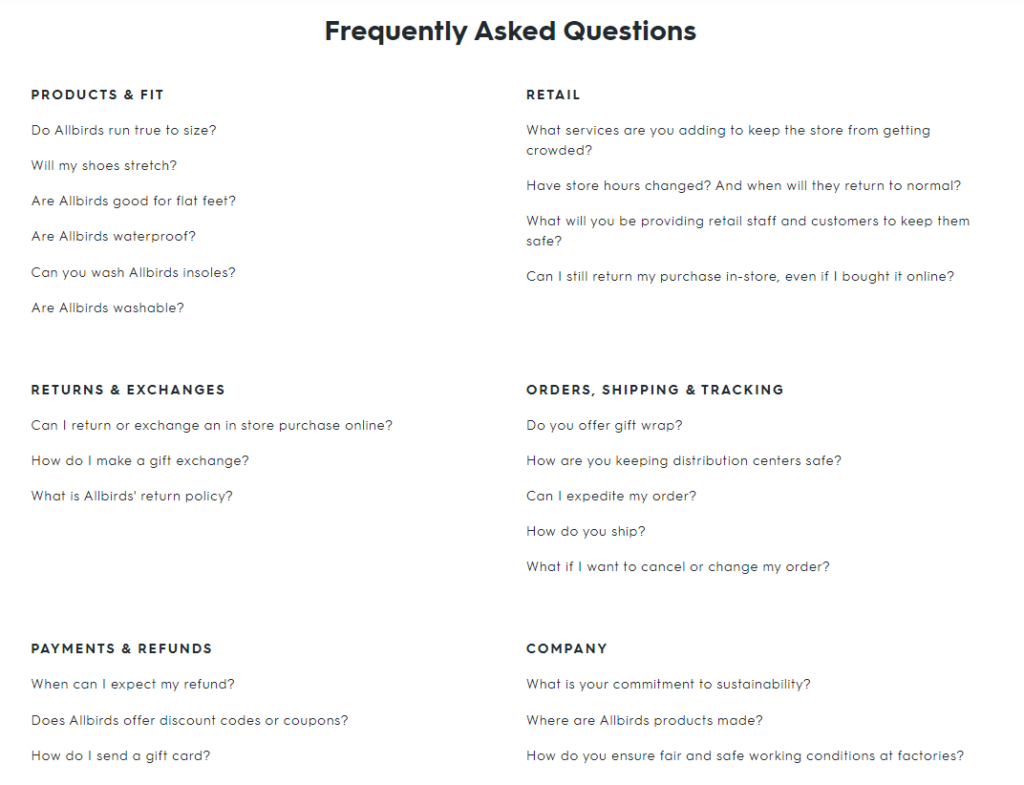
They cover fit, sizing, half sizes, stretch, wide feet, returns, exchanges, refunds, and shipping—precisely the topics that make or break a footwear purchase.
For example, if you have flat feet, you’ll quickly find guidance under “Products & Fit.” Clear, specific answers build confidence and reduce returns.
These are logical pre-purchase questions. The more certainty you provide, the easier it is for shoppers to commit.
Buying shoes online is inherently uncertain—you can’t try them on. Great FAQs reduce that uncertainty by answering what customers actually ask, not what the company wishes they asked.
Maintain a running database of questions. Tag them by product, funnel stage, and frequency. When the same question appears repeatedly, it belongs in your FAQs—updated as products, policies, or seasons change.
Review and refresh your FAQ regularly—especially after launches, pricing changes, new shipping zones, or policy updates—so the page stays accurate and trustworthy.
Simplify the Navigation
Like the rest of your site, your FAQ must be frictionless. Strong questions and answers don’t matter if people can’t find them.
Model the experience on helpful in-store assistance: quick triage, clear categories, and immediate answers. Don’t force visitors to hunt through walls of text.
If your page is a long list of questions with full answers stacked underneath, users will scroll endlessly, miss key items, and leave frustrated. Use categories, accordions, jump links, and an on-page search to shorten the path to an answer.
Take a look at how Microsoft structures its FAQ for software downloads.
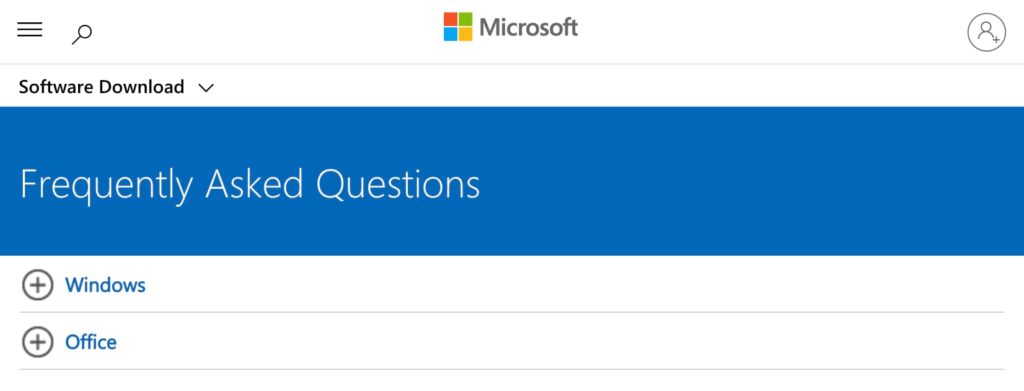
Right away, there are clear categories to choose from, which prevents irrelevant items from getting in the way.
Clicking a category expands the menu in place, avoiding page reloads and keeping users oriented.
Here’s what it looks like if we click on Office.
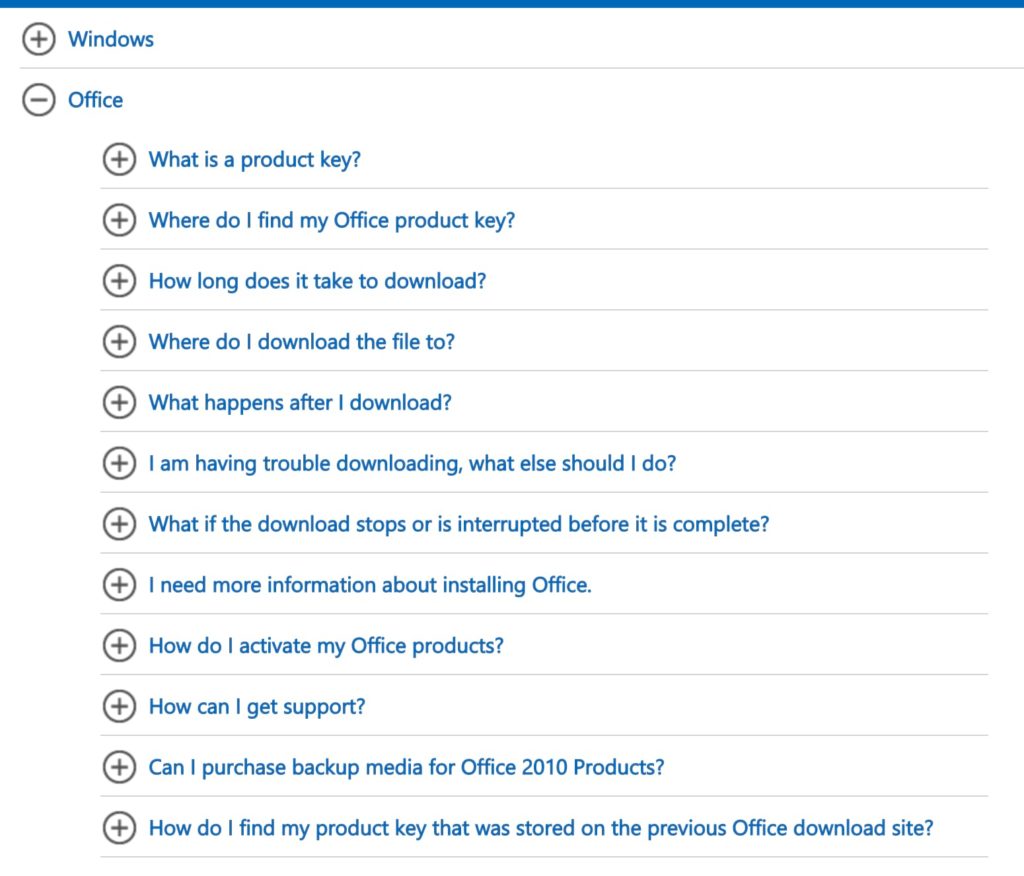
All 12 questions are visible without scrolling, making it effortless to scan and select.
If every answer lived directly below its question, the page would balloon and become tedious to navigate. Microsoft’s expandable approach keeps things clean and fast.
When you click a specific question—like “How long does the software download take?”—the answer expands inline. Simple and predictable.
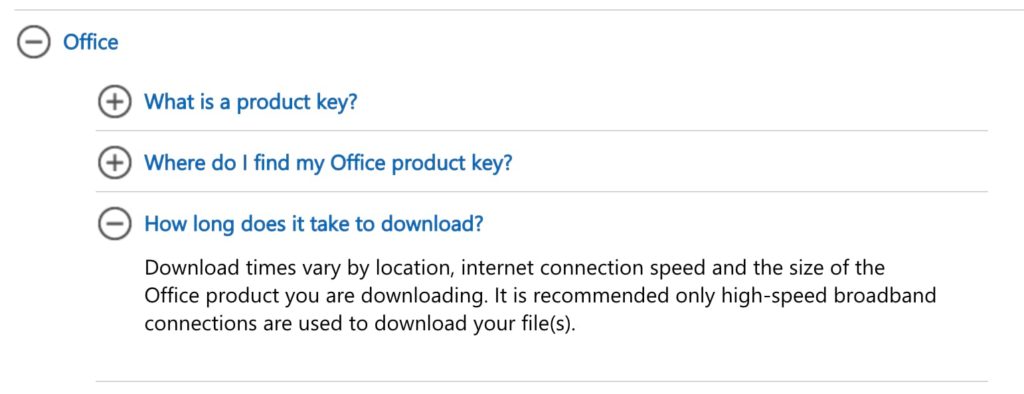
Frictionless.
Even if a visitor has several questions, this structure makes it easy to move quickly between them. Add quality-of-life features like a sticky in-page table of contents, “back to top” links, persistent search, and a visible contact option.
If a question isn’t answered, a conversion won’t happen. Make navigation obvious, mobile-friendly, and accessible (keyboard navigable, clear focus states, and descriptive headings). The easier the experience, the higher the conversion rate.
Think of this page as your always-available store associate. It should anticipate needs, give instant guidance, and make the next step unmistakable.
Keep the Answers Short
Another frequent mistake is long-winded answers. Keep responses clear and concise so users can get what they need at a glance.
Your FAQ should be broad and broadly useful. Save edge-case details for product pages, docs, or help articles. If someone needs more, give them a path: “Read the full guide,” “See pricing details,” or “Contact support.”
Even for popular questions, aim for brevity. Provide a direct answer first, in plain language, then offer a link for deeper reading. As a rule of thumb, 2–4 sentences (or about 40–80 words) is plenty for most items.
It’s better to list more focused questions with short answers than fewer questions with essay-length responses. If an answer feels long, split the question into a couple of tighter, more specific ones.
Visitors shouldn’t have to parse big blocks of text to get a simple answer. Long copy can create new questions—or scare people off entirely.
So, sharpen your writing: define jargon, write at an approachable reading level, and lead with the most important sentence.
Check out this example from the PayPal FAQ page.
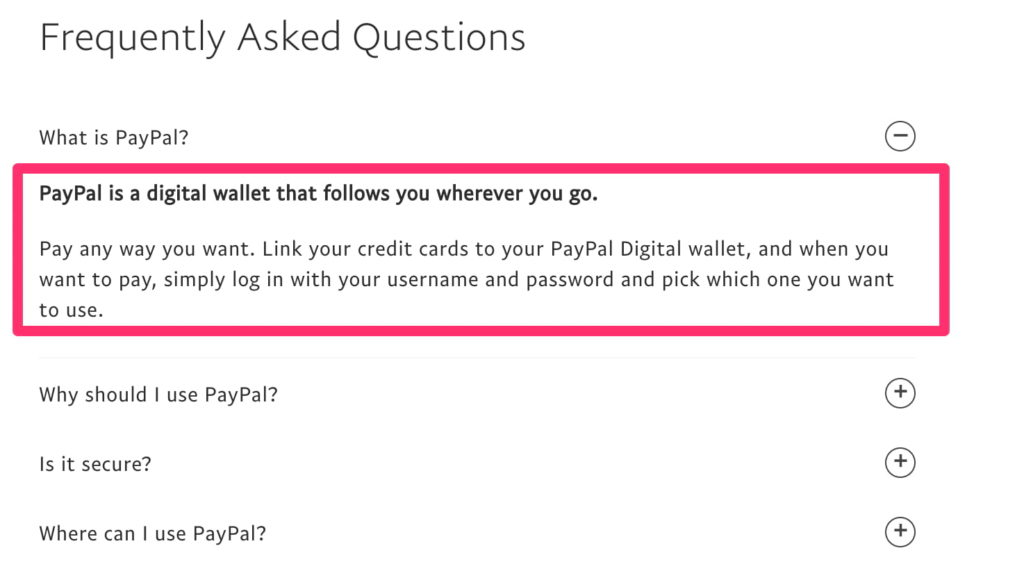
“What is PayPal?” could invite a 50-page answer. Instead, they keep it to three sentences—enough to orient a newcomer and point them to the next step.
Use that approach: answer directly in a few sentences, then link to specifics like fees, business features, or integrations if someone wants more.
Offer Added Support
Even the best FAQs won’t cover every scenario. Some visitors will still need help—that’s normal.
If a little extra support is what it takes to convert, make it easy. Offer multiple contact paths and surface them contextually where questions arise.
Make support options obvious on the page. Here’s how Samsung approaches it.
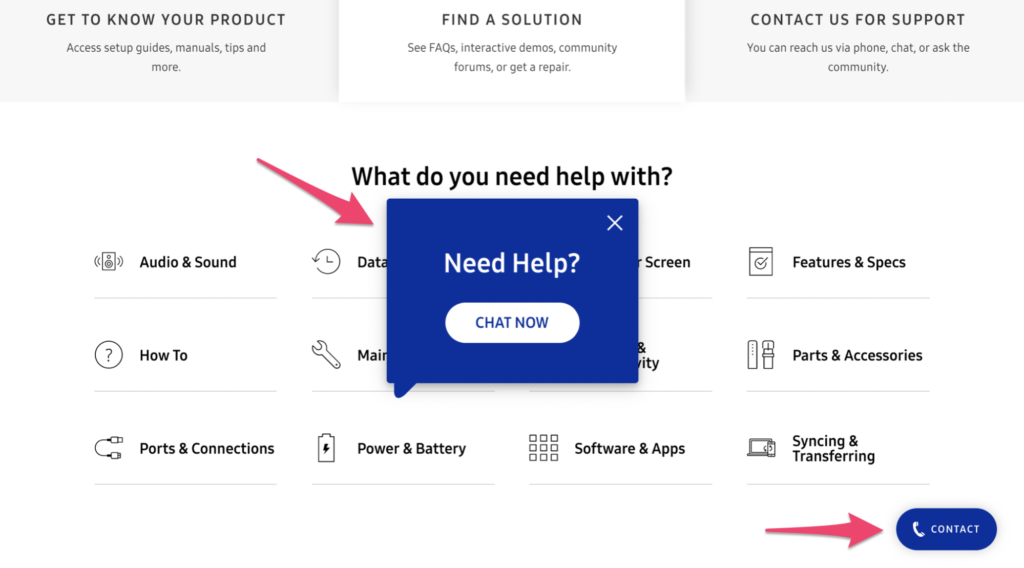
They start with categories—which makes sense for a large catalog. If you pause without interacting, a live-chat prompt appears to offer real-time help.
This proactive assist prevents users from bouncing to a separate support page or endlessly clicking through menus. Samsung also keeps phone support visible so people can choose the channel they prefer.
Can’t find an answer? No problem—call, chat, or submit a ticket right from the FAQ. You can even embed a quick “Was this helpful?” widget to collect feedback and trigger follow-up options when users say “No.”
If you want maximum conversions, make live help a single click away. The incremental effort pays off in saved sales and fewer abandoned carts.
Optimize for SEO
Your FAQ should pull its weight in search. Many visitors will arrive from product pages—but well-structured FAQs can also capture organic traffic directly.
Mix brand-specific items with non-branded, educational questions your audience searches for. For example, if you offer web hosting plans for small businesses, include “What is shared hosting?” or “When should I choose VPS over shared hosting?” alongside your plan details.
Write each question in natural language—the way people search. Lead with the answer (the “short version”), then add a link to a deeper resource.
Use Google to discover phrasing and intent variations. Start with a target query (e.g., “sneakers for travel”) and review related searches for topic ideas.
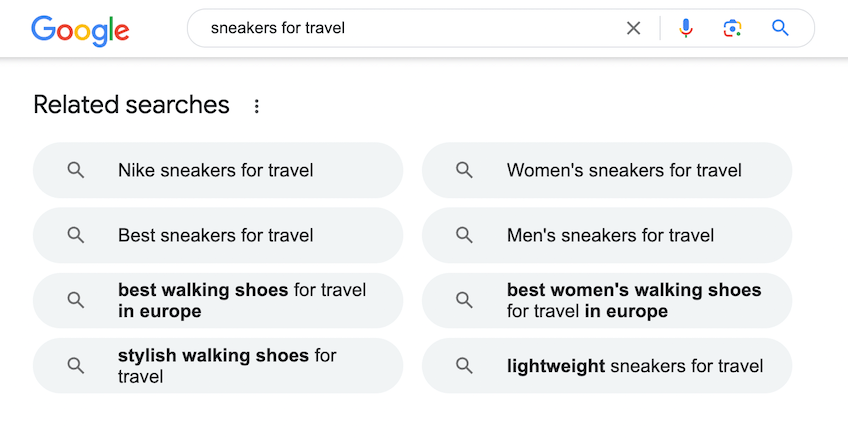
Turn “Related searches” into FAQs that match real language—like “best shoes for walking all day” or “stylish walking shoes for Europe.”
Also study the “People also ask” module for question wording and follow-up intent.
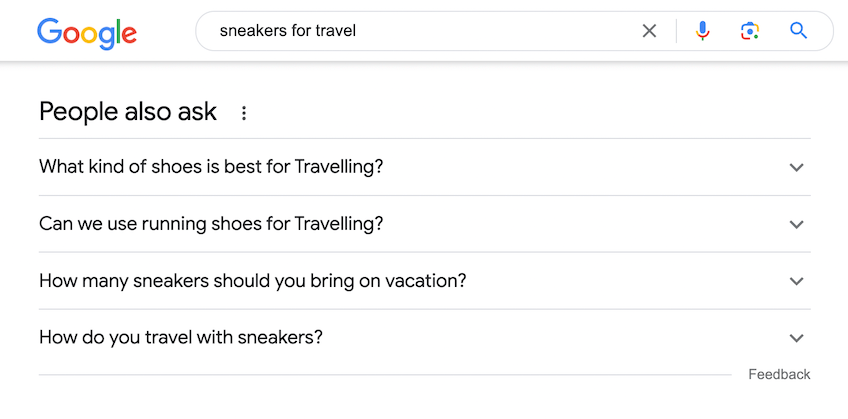
Answering these questions can improve relevance and capture intent-driven traffic while giving visitors the clarity they came for.
Technical tips: use descriptive H2/H3 headings, add internal links to deeper resources, and keep questions on a single, crawlable page (or a few well-organized pages) with clean URLs. Implement FAQ structured data to help search engines understand the Q&A format—even as eligibility for special rich results may change over time.
How to Understand Your Audience Using Quality Customer Research
High-converting FAQs start with customer insight. When you answer the questions that truly matter, you reduce support load and increase revenue. Here are straightforward ways to gather that insight.
There are countless methods, but these will get you moving quickly. Afterward, explore the deeper research approaches that make your FAQs even sharper.
Create a Survey
Surveys give you scalable input on questions, objections, and language. Keep them short, ask one thing per question, and mix multiple-choice (for trends) with open-ended prompts (for wording you can reuse verbatim on your page).
Ask what nearly stopped them from buying, what confused them, and what they wish they’d known sooner. That’s your FAQ roadmap.
Conduct 1-on-1 Interviews with Customers
The highest-quality insights come from direct conversations. Meet via video or phone and have customers narrate their buying process, from first impression to checkout. Listen for hesitations, comparisons, and phrases you can mirror in your answers.
In-person isn’t required; remote interviews work well. Always compensate participants with cash or store credit to respect their time.
After interviews, turn recurring concerns into clear questions and short answers. Link to deeper resources for advanced cases.
Next, collect feedback continuously with a simple comment box.
This one’s easy. Simply add a customer feedback form onto your website where people can share their thoughts and opinions. Here’s an example of one from BuildFire.
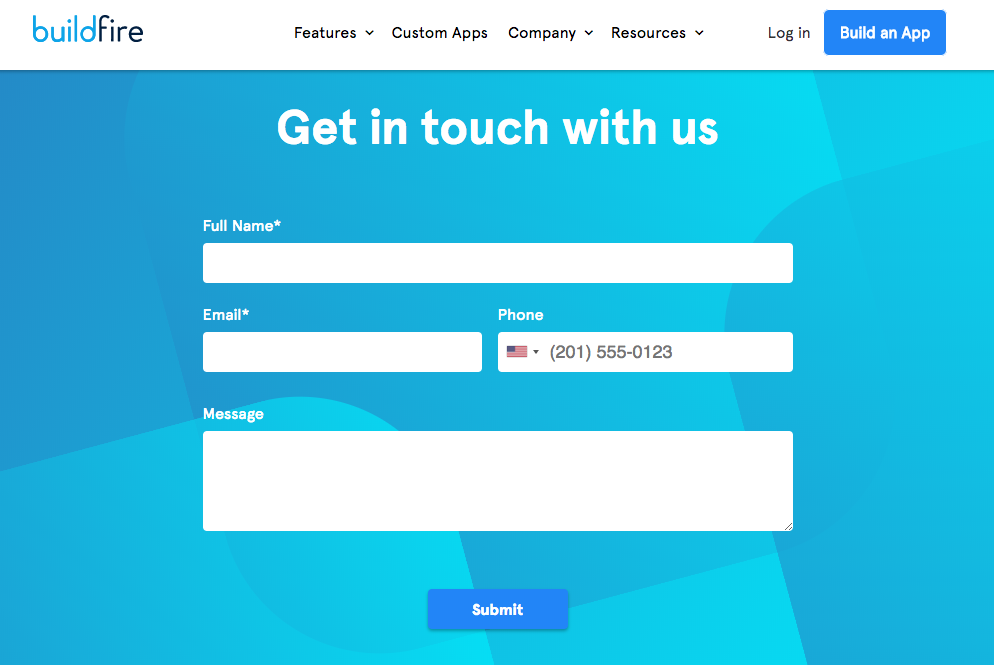
You don’t have to collect names or contact information, though it helps if you want to follow up for an interview or detailed survey. Pair the form with an optional email field and brief consent, and you’ll build a steady pipeline of real customer questions.
Use these inputs to spot trends. When a new question appears repeatedly, add it to your FAQ and note the date updated so visitors know the information is current.
Conclusion
FAQ pages are critical resources for visitors on the verge of converting.
Often, a single clear answer is all it takes to finalize a decision. Don’t waste the opportunity with vague or outdated content.
Prioritize questions tied to conversions. Make the experience effortless with intuitive navigation and concise, plain-language answers. Offer fast access to live help for edge cases. And structure your page so it can win in search as well as onsite.
Build your FAQ with intention and maintain it. Review it after product updates, policy changes, and seasonal shifts. Track what people search on your site and what they ask support—then update the page to match.
If you follow the tips in this guide, your FAQ won’t just deflect tickets—it will drive conversions and give customers a better experience with your brand.
